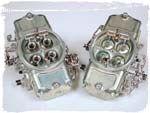
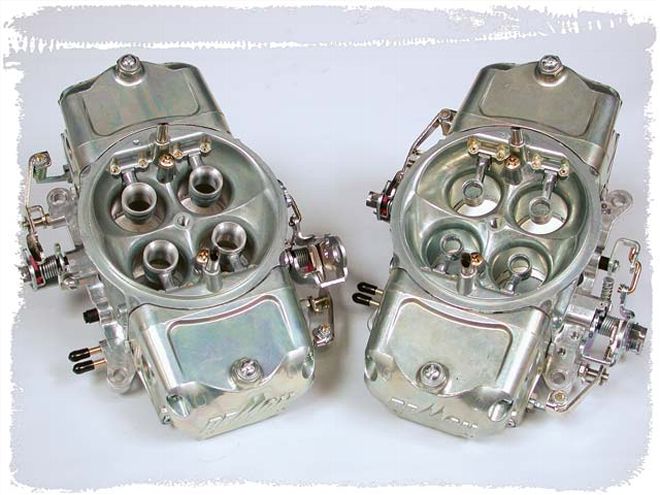 Demon created the annular-discharge 750-cfm carb (left) just for Car Craft, but now you can buy one, too. The dogleg carb is on the right.
Demon created the annular-discharge 750-cfm carb (left) just for Car Craft, but now you can buy one, too. The dogleg carb is on the right.
They say size is everything, and that seems to hold true with the connection between car crafters and carburetors. But there's more to mixing fuel and air than just cubic feet per minute. Often the differences in power and driveability are much more subtle, right down to the style of booster employed by the carburetor.
The buzz in the carburetor world has to do with annular-discharge boosters, so we tested the performance difference between annular-discharge boosters and the more common downleg (or dogleg) style. Before we jump into the tests we'll explain how a carburetor main circuit functions, why boosters are used, and how all that fuel-mixing voodoo comes about.
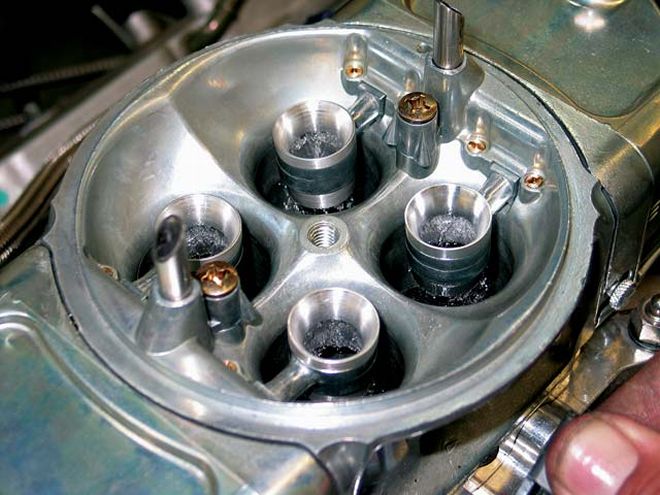 Annular
Annular
Booster Basics
All carburetors work on what is called Bernoulli's Principle, named for the 18th century scientist who discovered that pressure is inversely proportional to velocity. That means that as air speed increases, its pressure decreases. By tapering the carburetor inlet, air speed increases and pressure drops. This taper is called a venturi. The differential between the atmospheric pressure in the float bowl and the lower pressure in the venturi pushes fuel through the main jet and into the airstream from an outlet in the venturi.
Stone-Age carb designers quickly realized that making the venturi large enough to flow sufficient air reduced inlet velocity, which reduced the low-pressure signal, so they created a small
venturi inside the larger one and called it a booster, since it boosts the pressure drop. The booster is used to increase the "signal" or pressure differential especially at lower engine speeds to help move calibrated amounts of fuel from the float bowl into the engine.
Changing the shape and configuration of the booster affects not only how much fuel is added to the incoming air, but also how this fuel is distributed within the intake manifold. Today you can buy carburetors that flow huge volumes of air, but larger carburetors generally don't respond well at low engine speeds, so street-engine carb selection is often a compromise between max power and part-throttle driveability.
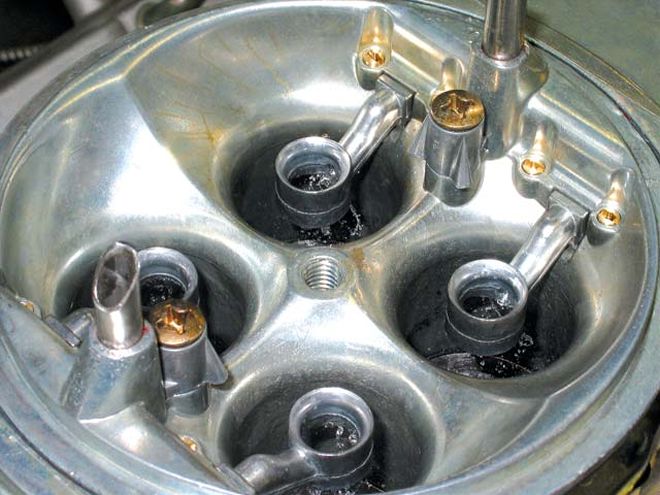 Dogleg
Dogleg
Booster Shot
In the early days of performance carburetors, boosters projected straight out from the upper portion of the carburetor barrel above the venturi. Later, downleg boosters were used to place the trailing end of the booster closer to the highest velocity point in the venturi. Both of these boosters employ a single fuel discharge point, relying on the shearing effect of high-velocity air moving past the booster to atomize the fuel.
Finally, there is the annular booster, which is slightly larger in diameter than the downleg and employs a series of small discharge holes drilled into the inside circumference of the booster to improve fuel atomization. This annular design accomplishes several things. At lower engine speeds, slow air speed creates a weak signal, which reduces the amount of fuel moving through the booster. An annular discharge booster's multiple holes offer many points for the fuel to enter the venturi as opposed to a single discharge point. At lower air speeds, this offers measurable advantages, especially when combined with the annular's better signal strength. This is important for situations where large-volume carburetors are used in conjunction with a long-duration camshaft. With a weak manifold-vacuum signal at idle, annular-discharge boosters can greatly improve throttle response and driveability.
Of course, annular boosters aren't exactly a free ride. First, the annular's larger size presents a slight airflow restriction, reducing the carburetors' total capacity compared to smaller downleg boosters. Second, with all other variables equal, an annular booster creates a stronger fuel signal, generally requiring smaller jet sizes. There are exceptions to this rule, but adding annular-discharge boosters requires smaller main jets and larger high-speed air bleeds compared to the downleg style.
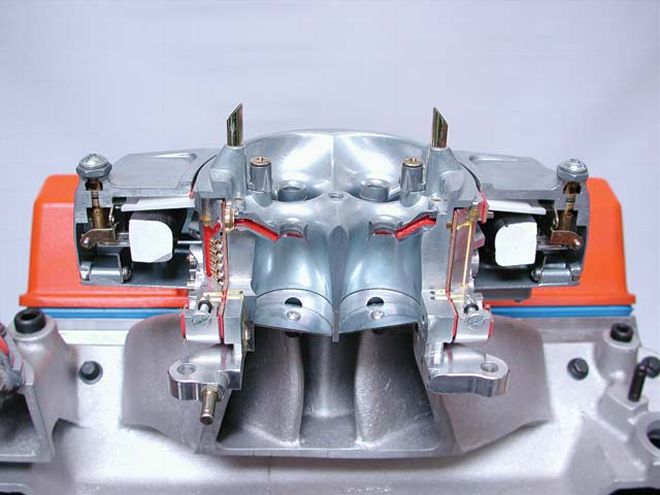 This cutaway Demon downleg-booster carb illustrates the fuel-flow path. Downleg boosters introduce fuel into the venturi through one large discharge hole.
This cutaway Demon downleg-booster carb illustrates the fuel-flow path. Downleg boosters introduce fuel into the venturi through one large discharge hole.
Test Time
We tested a brand-new 750-cfm addition to the Mighty Demon lineup that now offers annular boosters to see if there was a fuel-flow or power difference between it and the more common downleg style. Our testing was performed by Ed Taylor on Ken Duttweiler's Digalog Benchmark series dyno using a carbureted LS1 engine. The GM Performance Parts crate LS1 used a GMPP carbureted intake manifold conversion that includes an aluminum single-plane intake along with a complete new front casting that houses a new water pump, fuel pump, and distributor. The engine used a Crane PN 144HR00061 cam (222/234 at 0.050, 112-degree LDA), Crane 1.7:1 roller rockers, and GMPP CNC-ported LS6 heads.
To evaluate the strengths and weaknesses of both boosters, we began our wide-open-throttle dyno pulls at 1,800 rpm. That is the equivalent of nailing the throttle in a heavy car with a manual trans in overdrive at a slow highway cruise. While challenging, this isn't an unrealistic test. Each carburetor had to deal with a power range of 1,800 to 6,700 rpm.
We started with the annular-discharge carb, which required substantially richer than the out-of-the-box jetting but made a solid 513 hp and 443 lb-ft of torque. Jetting on either side of this combination merely lost power, so we stopped and bolted on the downleg-booster Mighty Demon 750. With that carb, jetting changes merely shifted the curve around but did not increase power. Our final jet combination with the downleg carb made slightly less peak power at 506 at 6,600 and 436 lb-ft at 5,600 rpm. But when we really studied all the numbers, they revealed some interesting information.
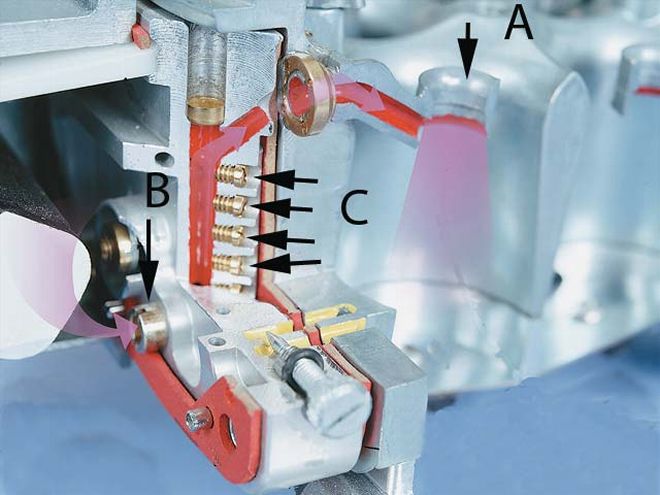
Numbers Game
To begin with, the downleg Demon flowed an amazing 65 cfm better than the annular carb at 6,700 rpm and flowed an average of 19 cfm more air throughout the entire test (even though the annular carb used a larger venturi and butterflies). This is because of the restriction that the larger annular boosters present to the carburetor. Generally, the carb that flows more air will also flow more fuel to match that airflow. However, the annular-discharge carb flowed more fuel and also made more power. The weird part of this is that when we tried to jet the downleg carb richer to approach the fuel curve generated by the annular carb, the engine always lost power.
This requires some explanation. While airflow through an engine is certainly important, it is not the only factor. Fuel conditioning, or the state in which the fuel enters the engine is also important. Cylinders that experience extremely lean air/fuel ratios or a small river of fuel running into individual ports are the two extreme examples of situations that will not promote optimal power. Ideally, maximum power is achieved when all the cylinders benefit from a homogenous mixture of properly proportioned air and fuel.
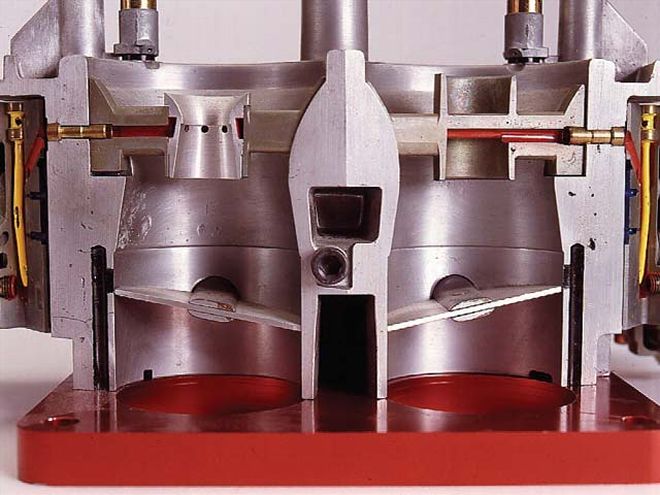 The annular-discharge booster uses several oval-shaped holes (arrows) to more finely atomize the fuel as it enters the engine. These multiple small holes better atomize the fuel into smaller droplets that mix more evenly with air as it enters the engine.
The annular-discharge booster uses several oval-shaped holes (arrows) to more finely atomize the fuel as it enters the engine. These multiple small holes better atomize the fuel into smaller droplets that mix more evenly with air as it enters the engine.
What we learned from this exercise with this particular engine is that the annular-discharge boosters did a much better job atomizing and distributing fuel and air compared to the downleg boosters. This is especially true at lower engine speeds. If you look at the power differences in the 1,800-2,400-rpm test points, it's clear how well the annular boosters work. The annular discharge carb was worth a staggering 94 lb-ft of torque at 1,800 rpm mainly because the downleg-booster carb was extremely unstable at that speed.
Whenever we increased jet sizes in the downleg carb, the low-speed power improved slightly at the cost of big horsepower numbers at higher engine speeds. Had we experimented with larger high-speed air bleeds on the downleg Mighty Demon carburetor, perhaps we could have come much closer to the overall power levels generated by the annular-equipped carburetor. We also could have modified the bleeds in both the primary and secondary metering blocks to improve the downlegs. Of course, the same modifications could also have been applied to idealize the annular carb as well.
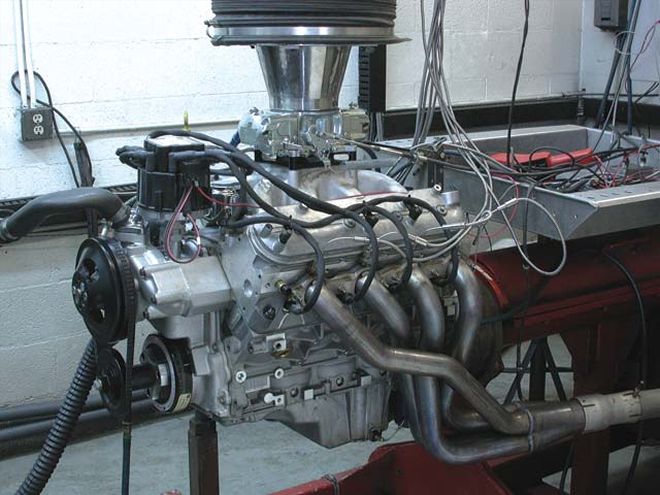 Our test engine was a GM 5.7L LS1 with a GM Performance Parts carbureted intake manifold and distributor conversion using a Performance Distributor HEI. The GM Performance Parts carbureted conversion kit includes an all-new casting to mount the distributor and mechanical fuel and water pumps. This also requires a new ATI balancer and pulleys.
Our test engine was a GM 5.7L LS1 with a GM Performance Parts carbureted intake manifold and distributor conversion using a Performance Distributor HEI. The GM Performance Parts carbureted conversion kit includes an all-new casting to mount the distributor and mechanical fuel and water pumps. This also requires a new ATI balancer and pulleys.
It's also important to point out that this one test should not be taken as a blanket endorsement of annular-discharge boosters for all applications. In this particular case, the peak power difference was a solid 7 hp, but even more impressive was the 20-lb-ft average torque increase. This illustrates why Barry Grant recommends using the annular-discharge carburetor on any engine with a camshaft duration of 220 degrees at 0.050 or more. What you can expect is that an annular-discharge carburetor would be an excellent choice to improve part-throttle driveability on a street car equipped with a long-duration camshaft and lots of overlap while also promising a slight overall power improvement. Annular boosters could also be a great addition to a slightly oversized carb as a way to improve its part-throttle manners.
Current Speed Demon and Mighty Demon carburetors do not have replaceable boosters like the Race Demon carburetors. But this doesn't mean you have to buy a new annular-discharge carb to take advantage of these boosters. For under $100, you can send your Speed Demon or Mighty Demon back to Barry Grant and the factory will install the proper annular-discharge boosters and matching high-speed air bleeds to make the conversion.
So whether you're looking for a new carburetor for your steroid-induced big-block or just looking for a way to improve the boulevard manners on your street burner, an annular-discharge carburetor might just be the boost your street machine needs.
`PARTS LISTDESCRIPTIONPNSOURCEPRICE750 Mighty Demon (down) 5402010GCJeg's$499.99750 Mighty Demon (annular)5423020GCJeg'sN/A{{{850}}} Mighty Demon (annular) 5563020GCJeg's499.99Fuel inlet kit, -6 line140020Jeg's44.95 `Power Play Test 1 used the downleg-booster-version 750 Mighty Demon using a 1.400-inch-diameter venturi and 111⁄16-inch butterflies. Best power-jet numbers ended up with 79 and 85s. Test 2 began with the annular-discharge-booster-equipped 750 Mighty Demon carb and the factory jetting. The annular Mighty Demon 750 uses a 0.250-inch-larger venturi (1.4250 inches) and a 0.0625-inch-larger butterfly (13⁄4 inches) compared to the downleg carb to compensate for the larger-diameter boosters, though it is still rated at 750 cfm. For best power we ended up with 76 primary and 82 secondary jets to achieve best overall power. TEST 1TEST 2DIFFDown LegFuelAnnular FuelFuelRPMTQHPlb/hrTQHPlb/hrTQHPlb/hr1,8002367958330113{{{57}}}9433-12,0002691035835413558853202,{{{200}}}29912658365153{{{62}}}662742,4003241486137016967462162,{{{600}}}3441706537518574311592,8003591917138020378211273,00037021179386221911610123,20037823087394{{{240}}}991610123,400384249964002591061610103,600389268105406278112171073,800394286114410296119161054,000399304123413314125141024,200{{{405}}}{{{323}}}13241633213311914,4004113431404203521429924,6004173641494243721527834,8004233861584303941637855,0004284081674354151747775,20043242917644043618687105,40043544818544345419786125,60043646619444247120765135,80043448020343848421644136,00043049021343149422314106,2004224982244245022302466,4004125022354175082385636,600402506246410513248872Avg.38732814040733614520116.7Peak436506246443513248943313Note: Averages were generated from the entire power curve every 100 rpm, which will be slightly different than the average of the above numbers.